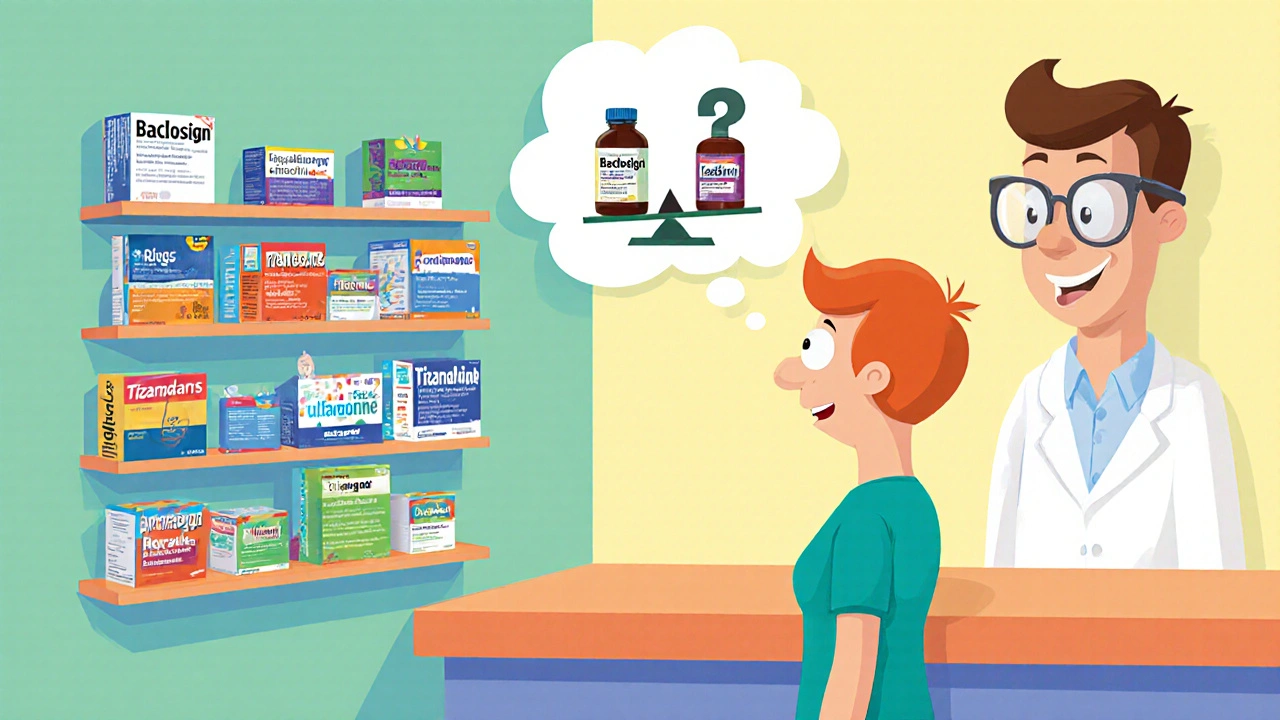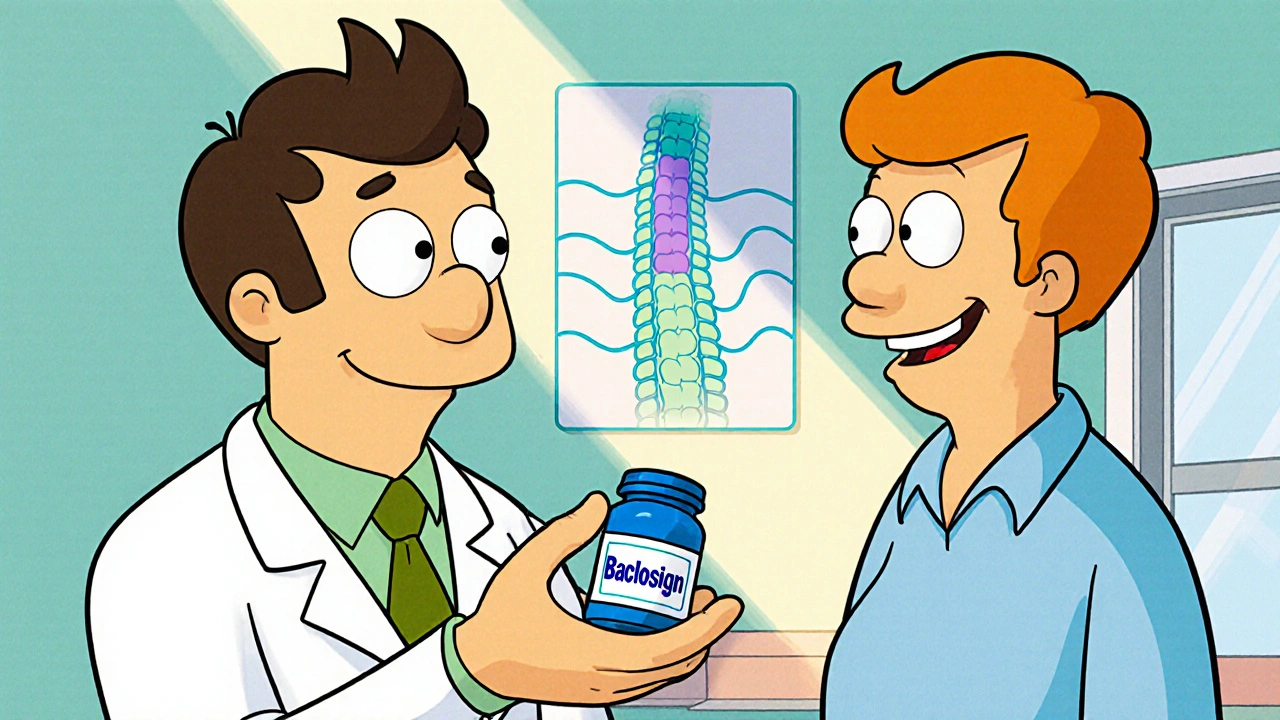Muscle Relaxant Selector Tool
Your Situation
Key Factors
For neurological spasticity:
Baclosign (baclofen) is often first-line for chronic neurological spasticity but requires careful dosing for patients with kidney issues.
For acute muscle strain:
Cyclobenzaprine and methocarbamol are preferred for short-term relief but may cause cardiac effects in older patients.
Cost considerations:
Generic baclofen is typically $30-$45/month while dantrolene can cost $200-$250 without insurance coverage.
Recommended Muscle Relaxants
When doctors prescribe a muscle relaxant, they’re often looking for something that eases painful spasms without causing too many new problems. Baclosign is the brand name for baclofen, a medication that works by calming down nerve signals in the spinal cord. It’s popular for conditions like multiple sclerosis‑related spasticity and severe back‑muscle cramps, but it isn’t the only option on the market. This guide walks you through how Baclosign stacks up against the most common alternatives, so you can decide whether it fits your needs or if another drug might serve you better.
What is Baclosign (Baclofen) and how does it work?
Baclosign belongs to a class of drugs called GABA‑B agonists. By binding to GABA‑B receptors in the central nervous system, it reduces the release of excitatory neurotransmitters that cause muscles to contract too hard. The result is a smoother, less painful muscle tone.
- Typical dose: 5 mg three times a day, gradually increased to 20‑40 mg three times daily depending on response.
- Onset: 30‑60 minutes after oral intake.
- Half‑life: About 2‑4 hours, which means dosing is usually spread throughout the day.
Because it works directly on the spinal cord, Baclosign is especially good for spasticity that originates from neurological disorders. It’s less useful for short‑term muscle strain after a workout.
Why look at alternatives?
Even though Baclosign is effective for many, several factors can push patients and clinicians toward a different drug:
- Side‑effect profile: Drowsiness, dizziness, and low blood pressure are common.
- Drug interactions: Baclosign can amplify the sedative effect of alcohol or other CNS depressants.
- Kidney or liver concerns: The medication is cleared primarily through the kidneys, so renal impairment may require dose adjustments.
- Cost and insurance coverage: Some insurers list Baclosign as a specialty drug, leading to higher out‑of‑pocket costs.
If any of these issues sound familiar, it’s worth examining the alternatives.
Common alternatives at a glance
The market offers several other muscle relaxants, each with its own mechanism and ideal use case. Below is a quick snapshot:
- Tizanidine: An α2‑adrenergic agonist that reduces spasticity by lowering nerve firing rates.
- Cyclobenzaprine: A tricyclic antidepressant derivative that works on the brainstem to relieve muscle tension.
- Diazepam (Valium): A benzodiazepine that enhances GABA‑A activity, delivering strong sedation and muscle relaxation.
- Gabapentin: Originally an anti‑seizure drug, it’s often used for neuropathic pain and spasticity.
- Dantrolene: Acts directly on skeletal muscle by inhibiting calcium release; used for malignant hyperthermia and severe spasticity.
- Methocarbamol: A central nervous system depressant that’s less potent but has a milder side‑effect load.

Side‑effect and safety comparison
| Drug | Common Side‑effects | Serious Risks | Contra‑indications |
|---|---|---|---|
| Baclosign (baclofen) | Drowsiness, dizziness, weakness | Seizure withdrawal, respiratory depression | Severe renal failure |
| Tizanidine | Dry mouth, fatigue, hypotension | Hepatotoxicity at high doses | Severe liver disease |
| Cyclobenzaprine | d>Dry mouth, constipation, blurred visionCardiac arrhythmias (especially in >65 yo) | Recent MI, uncontrolled glaucoma | |
| Diazepam | Sedation, ataxia, memory impairment | Respiratory depression, dependence | Acute narrow‑angle glaucoma |
| Gabapentin | Peripheral edema, dizziness, fatigue | Severe allergic reactions | Renal failure without dose reduction |
| Dantrolene | Weakness, nausea, diarrhea | Hepatotoxicity (monitor LFTs) | Severe liver disease |
| Methocarbamol | Drowsiness, headache, nausea | Rare anaphylaxis | Hypersensitivity to carbamates |
Notice how Baclosign shares drowsiness with many others, but its serious risks are linked to abrupt withdrawal. If you’ve experienced a seizure‐type event after stopping baclofen, a slower taper is essential.
Clinical efficacy and typical use cases
| Drug | Primary Indication | Evidence of Efficacy | Onset of Relief |
|---|---|---|---|
| Baclosign (baclofen) | MS‑related spasticity, spinal cord injury | Randomized trials show 30‑40% reduction in Ashworth scores | 1‑2 weeks (titration) |
| Tizanidine | Spasticity from ALS, MS | Meta‑analysis reports similar reduction to baclofen | 3‑5 days |
| Cyclobenzaprine | Acute muscle strain, short‑term spasms | Improves pain scores within 48 h in 60% of patients | Hours |
| Diazepam | Severe spasm, tetanus adjunct | Rapid relief but high sedation limits long‑term use | 30‑60 min |
| Gabapentin | Neuropathic pain with spasticity | Modest improvement in spasm frequency | 1‑2 weeks |
| Dantrolene | Severe generalized spasticity, malignant hyperthermia | Reduces muscle tone by up to 50% in trials | Days |
| Methocarbamol | Acute low‑back pain with spasm | Effective for pain relief, less for tone reduction | Hours |
Overall, Baclosign remains a top choice for chronic, neurologically driven spasticity, while drugs like cyclobenzaprine shine in short‑term injury scenarios.
Cost and accessibility overview
| Drug | Generic availability | Average cost (USD) | Typical insurance tier |
|---|---|---|---|
| Baclosign (baclofen) | Yes | $30‑$45 | Tier 2 |
| Tizanidine | Yes | $35‑$55 | Tier 2 |
| Cyclobenzaprine | Yes | $20‑$30 | Tier 1 |
| Diazepam | Yes | $15‑$25 | Tier 1 |
| Gabapentin | Yes | $25‑$40 | Tier 1 |
| Dantrolene | No (brand only) | $200‑$250 | Specialty tier |
| Methocarbamol | Yes | $20‑$35 | Tier 1 |
Cost can be a deciding factor if you’re paying out‑of‑pocket. Generic baclofen is reasonably priced, but specialty drugs like dantrolene can quickly become prohibitive.

How to choose the right muscle relaxant for you
Pick a drug based on three practical questions:
- What’s the underlying cause? Neurological spasticity points to Baclosign or tizanidine; acute injury favors cyclobenzaprine or methocarbamol.
- How much sedation can you tolerate? If you need to stay alert for work, avoid diazepam and high‑dose baclofen; lean toward methocarbamol or low‑dose tizanidine.
- What’s your health profile? Liver disease → tizanidine caution; kidney impairment → lower baclofen dose; pregnancy → avoid benzodiazepines.
Talk with your prescriber about these factors. Often, a short trial of two drugs (e.g., baclofen for 2 weeks then tizanidine for another 2) can reveal which one gives the best balance of relief and tolerability.
Quick cheat‑sheet for fast comparison
- Baclosign: Best for chronic neurologic spasticity, moderate sedation, cheap.
- Tizanidine: Faster onset, liver‑sensitive, good for daytime dosing.
- Cyclobenzaprine: Ideal for short‑term injuries, but watch heart health.
- Diazepam: Powerful, highly sedating, risk of dependence.
- Gabapentin: Helpful when pain accompanies spasm, renal dosing needed.
- Dantrolene: Direct muscle action, pricey, liver monitoring required.
- Methocarbamol: Milder, good for low‑risk patients, less tone control.
Frequently Asked Questions
Can I switch from Baclosign to another muscle relaxant without a washout period?
Usually you can cross‑taper-gradually lower the baclofen dose while introducing the new drug. A sudden stop can cause rebound spasticity or seizures, so a physician‑guided taper is safest.
Is Baclosign safe for older adults?
Yes, but start at the lowest dose (2.5‑5 mg) and watch for dizziness or falls. Renal function often declines with age, so dose adjustments may be needed.
How does Baclosign differ from Diazepam in terms of mechanism?
Baclosign targets GABA‑B receptors in the spinal cord, while Diazepam boosts GABA‑A activity throughout the brain. That’s why Diazepam is more sedating and carries a higher dependence risk.
Can I take Baclosign with alcohol?
It’s not recommended. Alcohol intensifies the CNS‑depressant effects, increasing dizziness, low blood pressure, and the chance of a fall.
What are the signs of baclofen withdrawal?
Symptoms can include high fever, agitation, hallucinations, seizures, and a rapid return of spasticity. If you miss a dose, contact your doctor right away.


Comments (11)
Poornima Ganesan
18 Oct, 2025Let me break down the whole Baclosign situation for you, because it seems nobody else bothered to list the nitty‑gritty. First, baclofen’s GABA‑B agonism isn’t just a buzzword; it directly damps the excitatory signals that cause spasticity, which is why it shines in chronic neurological cases. Second, the dosing schedule – 5 mg three times a day climbing to 20‑40 mg – is not something you can eyeball, you have to titrate carefully to avoid the dreaded drowsiness and weakness. Third, the half‑life of 2‑4 hours means you’ll be popping pills all day, unlike some long‑acting agents that let you sleep through dosing. Fourth, the withdrawal syndrome can be catastrophic: seizures, hyperthermia, and rebound spasticity are real risks if you stop cold turkey. Fifth, renal clearance is the primary route, so patients with impaired kidneys need dose cuts, something many prescribers overlook. Sixth, the cost factor is deceptive – generic baclofen is cheap, but insurance tiers can bump the price into the Tier 2 bracket, making it less accessible for some. Seventh, drug interactions are a minefield; combine baclofen with any CNS depressant, even over‑the‑counter antihistamines, and you’ll feel like a zombie. Eighth, compared to tizanidine’s hepatic metabolism, baclofen is safer for liver‑compromised folks, but you trade that for possible hypotension. Ninth, the evidence base – randomized trials show a 30‑40 % reduction in Ashworth scores – is solid, yet it doesn’t guarantee you won’t still need adjunct therapy. Tenth, alternatives like cyclobenzaprine work on the brainstem and are better for short‑term injuries, but they carry cardiac risks in the elderly. Eleventh, diazepam gives you instant relief but at the expense of dependence and profound sedation, which most patients can’t afford. Twelfth, gabapentin is useful when neuropathic pain co‑exists, but you’ll need renal dosing adjustments too. Thirteenth, dantrolene directly targets skeletal muscle calcium release, making it powerful but hepatotoxic; it’s a last‑resort for severe cases. Fourteenth, methocarbamol is the mild‑mannered cousin, offering lower sedation at the cost of weaker tone reduction. Fifteenth, patient preference often boils down to how much sedation they can tolerate while staying functional at work. Finally, the best approach is a shared decision‑making process with your neurologist, weighing efficacy, side‑effects, cost, and lifestyle, because no single drug is a universal silver bullet.
Brian Van Horne
18 Oct, 2025While I appreciate the thoroughness of the previous comment, I must note that the clinical guidelines also emphasize individualized titration protocols, which are paramount for optimal outcomes. Adherence to these protocols minimizes adverse events and maximizes functional improvement.
Norman Adams
18 Oct, 2025Oh great, another 'guide' that pretends to simplify what doctors have been debating for decades.
Margaret pope
18 Oct, 2025Look I get that it feels like a lot of info but the facts are there and they can help you make a better choice. Baclosign isn’t magic but it does work for many patients. If you’re worried about side effects start low and watch how you feel. Talk to your doc about tapering if you need to stop. You’ll be fine with the right plan.
Linda A
18 Oct, 2025In the theater of medicine, each muscle relaxant plays its part upon the stage of human suffering, yet the script remains unwritten until the patient steps into the spotlight. Baclosign, with its disciplined cadence, offers a measured melody amidst the cacophony of spasticity. The choice, therefore, becomes a quiet introspection rather than a boisterous proclamation.
Albert Fernàndez Chacón
19 Oct, 2025That’s a beautiful way to put it. I’ve seen folks who tried baclofen and felt a steady calm return to their daily routine. It’s not always dramatic, but those small wins add up over time. Keep the conversation open with your healthcare team.
Drew Waggoner
19 Oct, 2025Honestly I feel the weight of every decision when it comes to meds, and reading this gives me a sliver of hope that I’m not alone in the struggle.
Mike Hamilton
19 Oct, 2025From a global perspective, the availability of generic baclofen varies, and in some regions the cost can be a barrier that forces patients to look for alternatives like tizanidine or even traditional therapies. It's worth noting that cultural attitudes toward sedation differ, influencing prescribing habits across countries. This diversity highlights the importance of personalized medicine and the need for clinicians to stay informed about both pharmacology and patient values.
Matthew Miller
19 Oct, 2025Wow, that’s an eye‑opener! Let’s keep pushing forward and empower every patient to find the right balance – no more settling for “just okay.” Together we can break the silence around spasticity and champion smarter choices!
Liberty Moneybomb
19 Oct, 2025Honestly, the whole Baclosign hype is part of a larger pharma plot to keep us hooked on endless prescriptions while they pull strings behind the curtain. They cherry‑pick the studies, hide the withdrawal horror stories, and let insurers dictate what’s “affordable.” Wake up and question who really benefits from the status quo.
Alex Lineses
19 Oct, 2025While it’s understandable to feel skeptical about pharmaceutical influences, it’s also crucial to rely on peer‑reviewed evidence and transparent clinical guidelines. Engaging in open dialogue with your neurologist can demystify these concerns and help you make informed, evidence‑based decisions.